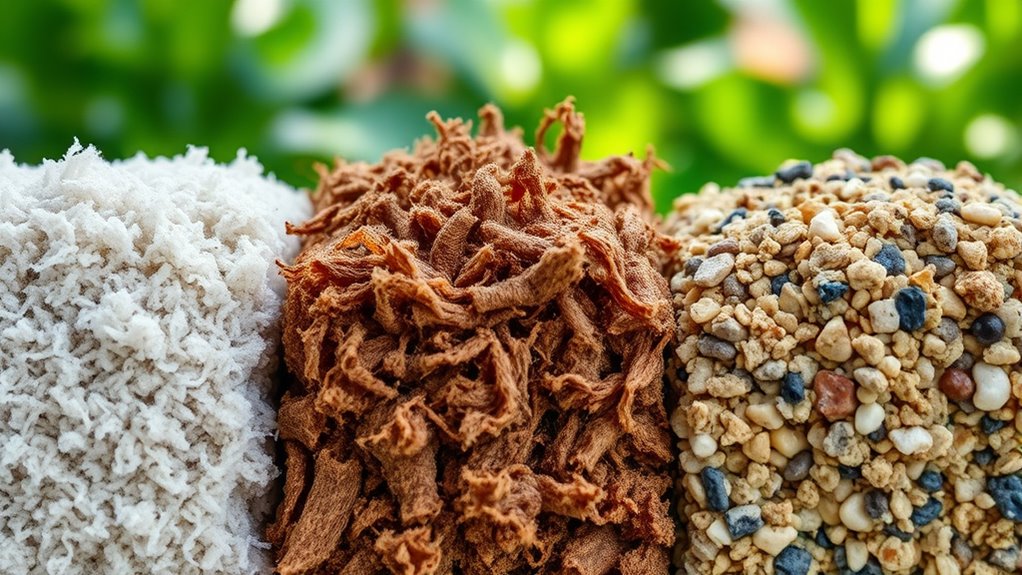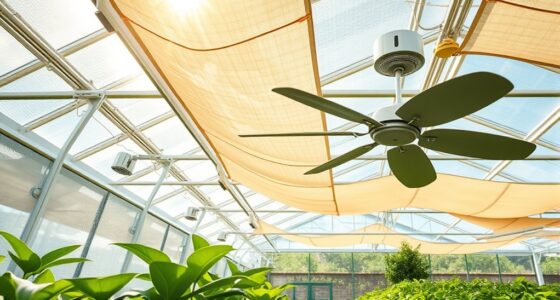Choosing the right substrate like Rockwool, coco, or alternatives is key to optimizing your plant growth and microbial health. Rockwool offers good water retention and drainage, but needs balanced watering. Coco coir holds moisture longer and benefits from regular nutrient supplements. Alternatives like perlite or clay pellets have unique properties suited for different needs. Understanding each substrate’s characteristics helps you manage moisture and nutrients better; explore further to master your cultivation setup.
Key Takeaways
- Rockwool retains water and drains efficiently, ideal for balanced watering routines.
- Coco coir holds moisture longer, requiring careful watering to prevent overwatering.
- Alternatives like perlite drain quickly, needing frequent watering; clay pellets offer good oxygen flow.
- Substrate choice affects nutrient management, with Rockwool needing balanced feeding and coco benefiting from regular supplementation.
- Monitoring moisture and pH levels helps optimize substrate performance and plant health.

Have you ever wondered what makes plants and microorganisms thrive in their environments? The answer often lies in the right choice of substrate and how you manage it. When it comes to substrates like Rockwool, coco, and alternatives, understanding their characteristics can help you optimize growth. One key aspect is watering frequency, which directly affects nutrient management. Too much water can drown roots and cause nutrient leaching, while too little hampers nutrient uptake and stunts growth. Striking the perfect balance means closely monitoring your substrate’s moisture levels and adjusting watering schedules accordingly. Rockwool, for example, retains water well but also drains effectively, so you need to establish a watering routine that keeps it moist without oversaturating. Coco coir, on the other hand, tends to hold onto water longer, making it essential to note its moisture retention properties to prevent overwatering. Proper nutrient management becomes essential here; with each substrate, you’ll need to tailor your nutrient solutions to match their water-holding capacities. For Rockwool, a balanced nutrient feed that considers its inert nature is important, while coco requires regular supplementation with nutrients that are easily absorbed in its organic matrix. Additionally, understanding the water retention properties of each substrate can help you fine-tune your watering practices more effectively.
Choosing the right substrate also involves considering its pH stability. Rockwool generally has a neutral pH, making it easier to control nutrient availability, but it still demands consistent monitoring. Coco coir tends to be slightly acidic, which might necessitate pH adjustments in your nutrient solution to prevent deficiencies. Alternatives like perlite or clay pellets have different properties—perlite offers excellent aeration but drains quickly, requiring more frequent watering, while clay pellets provide good oxygen flow but need less frequent watering. The key is understanding how each substrate interacts with watering frequency and nutrient management to keep your plants healthy.
Ultimately, successful cultivation depends on your ability to adapt your watering schedule and nutrient feeding based on the substrate’s characteristics. Regularly checking moisture levels with simple tools like a moisture meter or by touch helps you avoid over- or underwatering. Remember, each substrate’s unique qualities influence how often you need to water and how you manage nutrients. When you stay attentive to these factors, you’ll create an environment where plants can thrive, microorganisms flourish, and your grow operation becomes more productive and efficient. It’s all about understanding your chosen substrate and fine-tuning your approach to watering and nutrients for ideal growth.
Frequently Asked Questions
How Do Substrate Choices Affect Plant Nutrient Uptake?
Your substrate choice directly impacts nutrient uptake by influencing root aeration and water retention. Well-aerated substrates, like Rockwool, promote healthy roots, boosting nutrient absorption. Conversely, substrates with high water retention, such as Coco coir, make certain that consistent moisture but can sometimes limit oxygen flow. Balancing these factors helps your plants access nutrients efficiently, leading to healthier growth and better yields.
Are There Eco-Friendly Substrate Options Available?
Yes, eco-friendly substrate options are available. You can choose biodegradable substrates like coir, which breaks down naturally, or opt for organic substrate options such as compost-based mixes that improve sustainability. These alternatives reduce environmental impact and support healthier plant growth. By selecting biodegradable or organic substrates, you promote eco-conscious gardening practices while still providing your plants with the nutrients they need to thrive.
Which Substrates Are Best for Hydroponic Systems?
You should choose substrates that maximize hydroponic yields and are easy to sterilize. Rockwool provides excellent support and retains moisture well, boosting yields, but requires careful sterilization to prevent disease. Coco coir is eco-friendly, boosts yields, and sterilizes easily, making it a popular choice. Consider alternatives like perlite or clay pellets for good aeration and sterilization ease, helping you maintain a healthy, productive hydroponic system.
How Do Substrate Ph Levels Influence Plant Growth?
Understanding substrate pH levels is like fine-tuning a delicate instrument; it greatly influences your plant’s growth. If the pH is too acidic or alkaline, nutrient uptake becomes a challenge, stunting development. You can perform pH adjustment to maintain a balanced environment, ensuring nutrients are accessible. Striking the right pH balance, whether slightly acidic or alkaline, helps your plants thrive and reach their full potential.
Can Substrates Be Reused or Recycled Effectively?
Yes, you can reuse or recycle substrates effectively by sterilizing them to eliminate pests and pathogens. For biodegradable substrates like coco coir, you can compost or renew them for future use, reducing waste. Proper substrate sterilization restores its health and nutrient balance, making it suitable for reuse. Recycling substrates not only saves money but also supports sustainable practices, ensuring healthy plant growth while minimizing environmental impact.
Conclusion
Choosing the right substrate is like selecting the perfect foundation for a house—you want stability, support, and growth potential. Rockwool, coco, and alternatives each offer unique benefits suited to different needs. By understanding their characteristics, you can tailor your setup for peak results. Remember, your substrate is the backbone of healthy plants, so pick one that aligns with your goals and watch your garden flourish like a vibrant mosaic.










